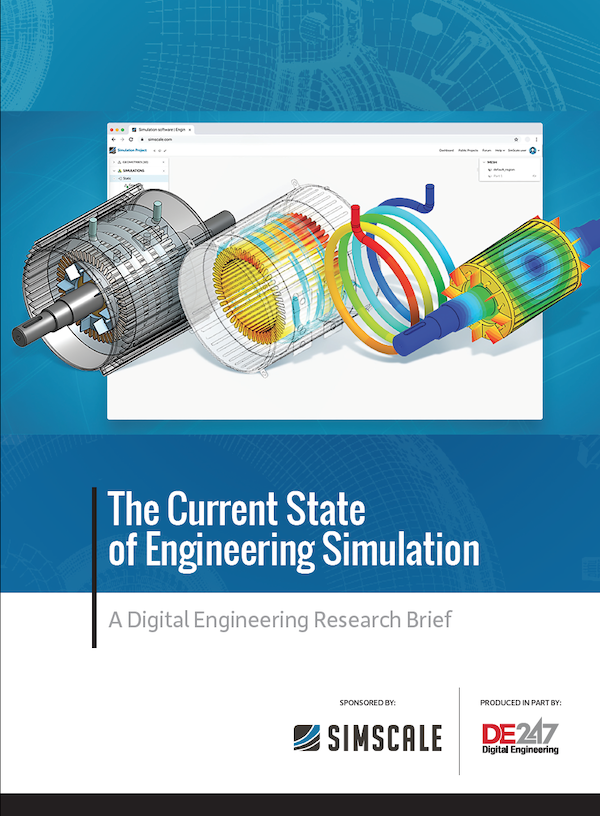Latest News
August 30, 2009
By Pamela J. Waterman
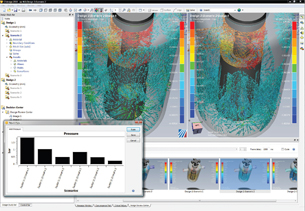 With CFdesign 2010 design engineers can easily and quickly set up a single or multi-scenario design study to help them make decisions that satisfy pass-fail, quality, and innovation objectives. Image courtesy of Blue Ridge Numerics |
Did you ever play Hot ‘n Cold tag when you were a child? Someone would call “warmer” or “colder” or “really, really hot” depending on how close you (in the blindfold) were to finding someone.
Fluid flow analysis software based on computational fluid dynamics (CFD) may not actually flash “warmer” or “colder” on its results screen, but it, too, should guide your efforts in a logical direction. In a strong shift from even five years ago, users are applying “what-if” CFD quite early in the design process to save time and cut back on prototypes and testing. This article identifies CFD package features that help users meet this challenge.
Software that Moves the Game
CFD is not a one-size-fits-all proposition, but useful analysis results at any speed require a common problem-solving protocol. Users need to first define the underlying issues and create a capability checklist (see sidebar). A good general resource is the set of CFD booklets available from NAFEMS, the not-for-profit international simulation organization.
A growing speed-driven trend is to use CAD-based CFD software that simplifies model transfer. For example, SolidWorks offers an embedded Flow Simulation option. Users save time since there is no need to transfer or rework geometry, and in fact no need to create separate fluid-volume geometry for the analysis. This allows users to make design changes based on fluid flow analysis and iterate the design without additional input. A wizard prompts for menu inputs, helping even inexperienced users quickly set up boundary conditions and material properties, define goals for output quantities, and create useful displays of parameter results.
Back to Basics – Defining the Essentials To zero in on viable CFD software, start by generating a list of the types of fluid flow problems you expect to solve. List the software requirements and features that you believe are necessary. Contact CFD software development companies and review their product literature against your list. Next, talk to analysts who perform similar simulations and learn about their experiences with each CFD program you are considering. Then, request trial usage of candidate CFD packages to be certain that they can accurately model your physics and are easy to use. Further, consider the balance between the package’s cost and features. Are you buying an annual lease or a perpetual license? What is the cost of additional processors and additional features? Features to look for include: — Roxanne Abul-Haj, ARA Engineering, Inc. |
Taking the CFD vendor point of view, CFD-CADalyzer from ESI Group supports both rapid sequential and parallel CFD simulations. Working directly on a CAD model, the analysis software is packaged in versions tailored for Pro/ENGINEER, SolidWorks, Solid Edge, Autodesk Inventor, and other MCAD products. One user describes it as providing first-order estimates in a matter of minutes.
Mentor Graphics Mechanical Analysis Division (formerly Flomerics) offers its FloEFD electronics cooling analysis software embedded in CAD packages such as Pro/ENGINEER Wildfire and CATIA V5. The company says FloEFD saves time by automatically creating the relevant fluid domain as differentiated from the solid model. Users can also quickly create multiple design variations by modifying just the CAD model without having to reapply loads, boundary conditions, and material properties for each variation.
Blue Ridge Numerics has been continuously improving its CFdesign software, which is opened from and associative with eight CAD packages. A new design tree structure lets users clone and edit not only model designs but complete scenarios of loads and materials. One design is automatically meshed, then many lightweight scenarios are quickly run for comparison. Users can also save time by assigning mesh regions and changing the mesh in just one area. Low memory needs permit real-time operation on laptop systems.
To speed up the human decision-making process, CFdesign has added two more capabilities. A Decision Center presents a unified interactive view of product performance and a new Design Review Center hosts a unique filmstrip approach to viewing simultaneous, multiple views for easy comparison. Additional software modules incorporate higher levels of underlying physics and simplify analysis speedup via networked high-performance computing resources.
CD-adapco’s STAR-CAD series enables engineers to quickly evaluate “what-if” design scenarios with its bidirectionally associative versions for CATIA 5, NX, Pro/ENGINEER, and SolidWorks. Based on its STAR-CCM+ finite volume product, the specific versions offer CAD-to-postprocessing functions built with automation in mind. Users need only prepare a simulation for the first design configuration. The same template and settings for physical setup, geometry repair, meshing, solution, and postprocessing are automatically applied. Optional Power Session licensing allows simultaneous solutions on multicore processors, speeding up the investigation of multiple design variations.
More Ways to Step Up the Pace
CAD-based CFD continues to add capabilities, but the attraction of blending usability with power has led more traditional developers to tackle this challenge, too. From ANSYS to NEi, companies across the industry have added software features to compress the design process.
 Flow through a shell heat exchanger analyzed with CHAM PHOENICS software, including 3D and 2D solution views. The 2D solution allows the flexibility of investigation of detailed flow around the tubes, which cannot be handled by current computers in 3D. Images courtesy of CHAM |
ANSYS’ Workbench framework offers bidirectional parametric CAD associativity as a starting point for all its products, including CFX and Fluent CFD packages. (Of note is both solvers’ capability to scale up to use parallel processors.) Then ANSYS DesignModeler and DesignXplorer support two approaches to narrowing design variations. ANSYS users can define a range of values for geometry, material properties, and boundary conditions, and DesignModeler will run those scenarios automatically. To go beyond manual “what if” simulations, DesignXplorer links to the parameter manager and lets you find out, say, what happens if you change air velocity by 10 percent.
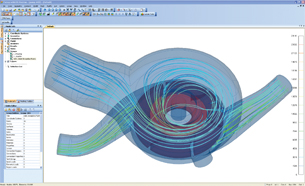 Femap Flow from Siemens PLM lets users quickly investigate “what-if” studies by re-using the same CFD domain with multiple locations of boundary conditions. Image courtesy of Siemens PLM |
COMSOL Multiphysics software uses associativity to cut down on analysis time, whereby any changes in geometry cause a corresponding update in the boundary conditions and fluid properties. The package provides a multiparameter sweep tool for varying model values and a multivariable Optimization Lab for zeroing in on the optimized set. COMSOL Multiphysics also scales linearly with the number of nodes to take advantage of compute-cluster efficiency.
At Concentration Heat and Momentum (CHAM), PHOENICS software helps users quickly run hundreds of simulations via a Relational Data input that links together common features. It stores them in a concise Parameterised Input File (PIF) from which the relevant parameters are automatically retrieved for specific trial combinations. Application-specific “gateways” speed up PIF definitions, and a Constant-Optimising Package automatically searches for optimum results based on user-defined ranges.
NISA/3D-Fluid from Cranes Software is a general-purpose CFD code for fluid-flow and heat-transfer problems. It can handle a wide range of high-end problems, from the mixing and combustion of multiple species to fluid flow at hypersonic speeds. Yet it also works at the designer level by automatically placing a mesh and analyzing initial geometry, then retaining all boundary conditions and analysis parameters for subsequent runs with finer details.
Siemens PLM offers strongly coupled flow and thermal analyses within its Femap Flow product. By connecting directly to Solid Edge geometry, Femap synchronizes the CAD and CFD components and allows easy CAD changes for updating the flow model. Extensive geometry clean-up tools help with model setup while “what-if” studies save time by reusing the same CFD domain under multiple boundary conditions. Fluid domain connections are also automatically created between disjoint and dissimilar element interfaces.
ALGOR’s FEMPRO package simplifies analysis setup by automatically generating the fluid medium around the CAD model without the user having to define it surface by surface. The company’s Design Scenarios approach to analysis means that users can set up a batch of scenarios with varying loads and constraint sets, and with one click tell the software to run through all of them. Users can also monitor results in real time and make changes as necessary.
With FLOW-3D from Flow Science, quick design iterations stem from the independence of mesh and geometry. The software uses a unique fractional areas/volumes (FAVOR) approach to defining problem geometry, and a fast, free-gridding technique for mesh generation. A Navigator function manages batch simulation scheduling, and the parallelization of the codes permits efficient use of multiprocessor resources.
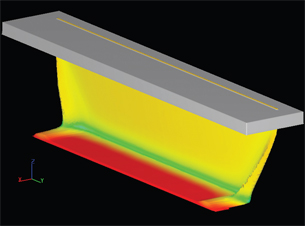 FLOW-3D’s FAVOR method supports rapid and easy mesh generation of a slot-coating apparatus and subsequent flow simulation. The device issues a coating liquid through the narrow slot onto a smooth, flat surface that is sliding by. The result is a very uniform and thin film of liquid such as paint, an emulsion, or a protective coating. Image courtesy of Flow Science |
NEi software has recently added a CFD capability to its analysis suite, incorporating Tdyn from Compass IS. NEi CFD now offers fast fluid-flow solutions due to its integrated pre- and postprocessing environment and easy-to-use coupled-variable utility. It also includes wizard assistant tools at each step of the process, and allows user-defined functions for physical properties and boundary definitions.
Taking a Different Slant
Hanley Innovations focuses on rapid aerodynamics conceptual analysis and design with its inexpensive, pay-as-you-go Stallion 3D CFD package. Given an .stl CAD input file, the software uses an automatic grid-generation process. Eliminating human interaction for each design change greatly speeds up solution times. Users can also view intermediate solutions and make real-time adjustments (e.g., to grid size) as needed.
Scripting offers another way to speed up multiple analyses. Cradle North America, a regional division of Software Cradle, markets SC/Tetra (unstructured mesh) and STREAM (structured mesh) full CFD programs with parallel licensing options. Both packages accept command lines executed from external programs, allowing users to create automated processes from geometry import to postprocessing tasks.
To generate multiple simulations from a master file, ACRi includes a “meta” command that works across its suite of CFD packages including ANSWER for general analysis. The function supports multiple studies of sensitivities, stochastic and/or objective-function optimization simulations. A highly intuitive CFDStudio GUI lets users make quick changes in geometry, input, or output functions.
Acknowledging that speedups are beneficial across the full scope of a CFD solution, some companies have put major efforts into targeted slices of the problem. For example, while partnering with CD-adapco to offer a CFD solver capability, SIMULIA also markets its own Isight optimization tool that helps users conduct fast design tradeoff studies.
Exa’s Power Flow analysis has always been a time saver because of the way it automatically discretizes the fluid domain. Now the company has developed a new preprocessor called PowerDelta that not only heals and meshes parts quickly, but also creates a workflow and history tree for managing the design process. A feature-based tool simplifies modifications throughout the model, speeding up “front-loaded” tasks for fast total analysis.
MSC Software markets FluidConnection, a CFD preprocessor that uses a new concept, abstract modeling, in an object-oriented way without the need for specific geometry. Designed to work with, not replace, existing engineering software tools, it parametrically supports major CAD and CFD applications, and automatically generates the mesh without the need for expert assistance. Productivity across an overall simulation is also increased through use of a new SimManager CFD Connect process management module.
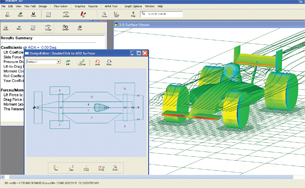 Aerodynamic flow past a race car, with colors depicting pressure, as designed in the built-in editor of Stallion 3D from Hanley Innovations. Automatic grid generation detects immersed boundaries without the need for user intervention. Image courtesy of Hanley Innovations |
Metacomp Technologies says that one of the keys to its speed is the unified preprocessing of structured, unstructured, and multi-block grids. And, quite beyond the scope of this article, you’ll find benefits with TrueGrid and GridGen preprocessing software and EnSight and Tecplot postprocessing packages. Their power can cut the time needed to set up any analysis and mull the significance of its results.
The Usual Caveats
Over the past decade, FEA software has moved successfully into the designer toolbox. However, since CFD analyses face the often greater challenges of nonlinear behavior and many more possible algorithms, results can be much more sensitive to small differences in initial conditions. The skill of the designer must be matched to the operation of the software.
You will find different packages list similar functions, so ask questions about what they don’t mention. With solid answers, you will identify which package leads to your best design path.
COMPANIES MENTIONED
ACRi
Concentration Heat and Momentum (CHAM) Ltd.
Mentor Graphics Mechanical Analysis Division (formerly Flomerics)R
XYZ Scientific Applications, Inc.
Contributing Editor Pamela J. Waterman is an electrical engineer and freelance technical writer based in Arizona. You can contact her about this article via e-mail sent to [email protected].
Subscribe to our FREE magazine, FREE email newsletters or both!
Latest News
About the Author
Pamela Waterman worked as Digital Engineering’s contributing editor for two decades. Contact her via .(JavaScript must be enabled to view this email address).
Follow DE




